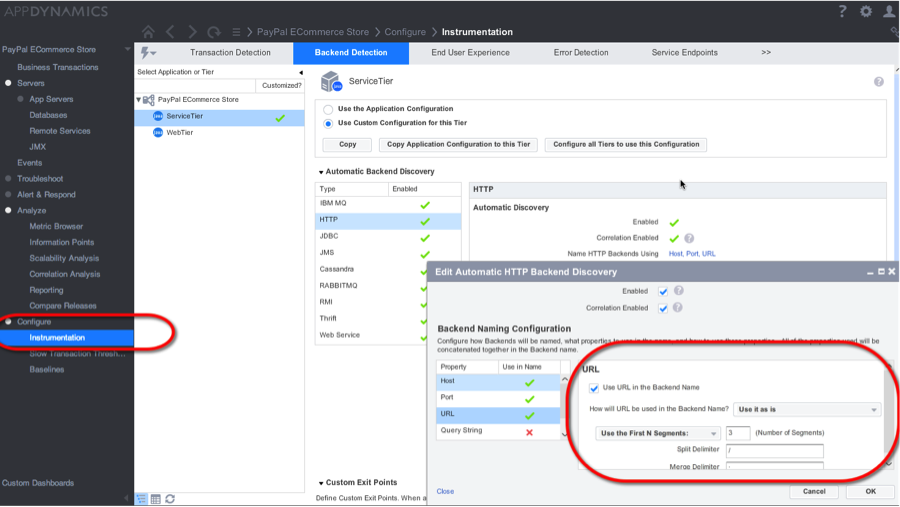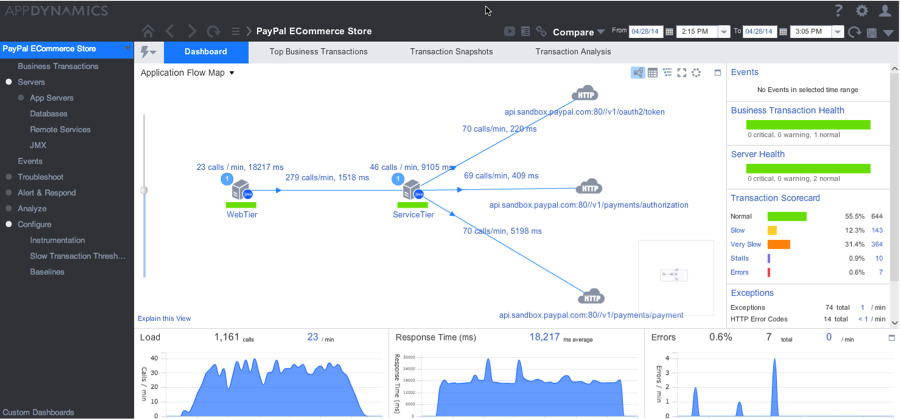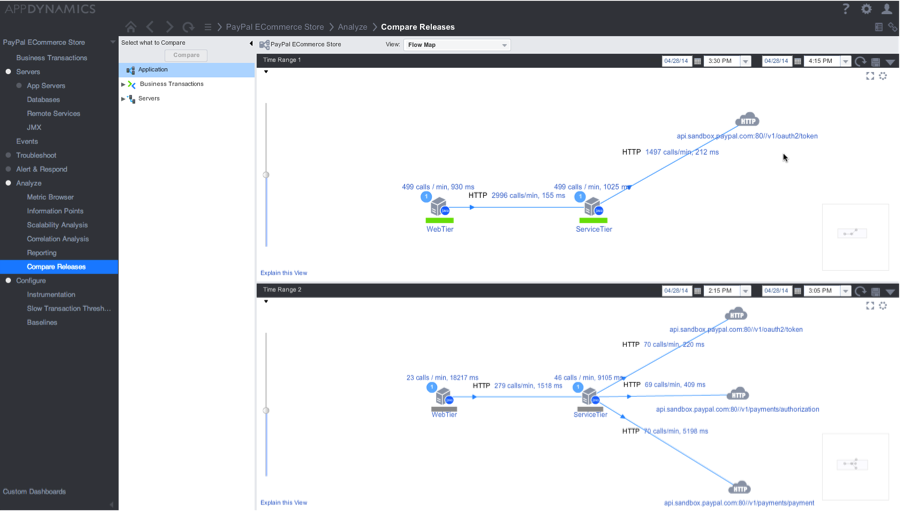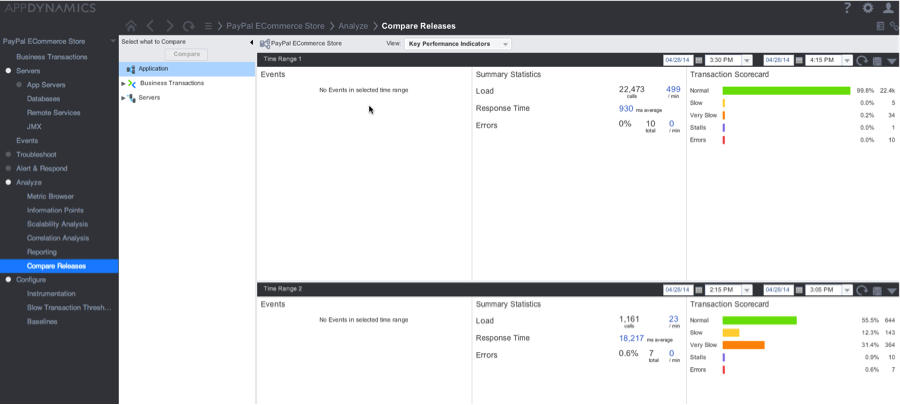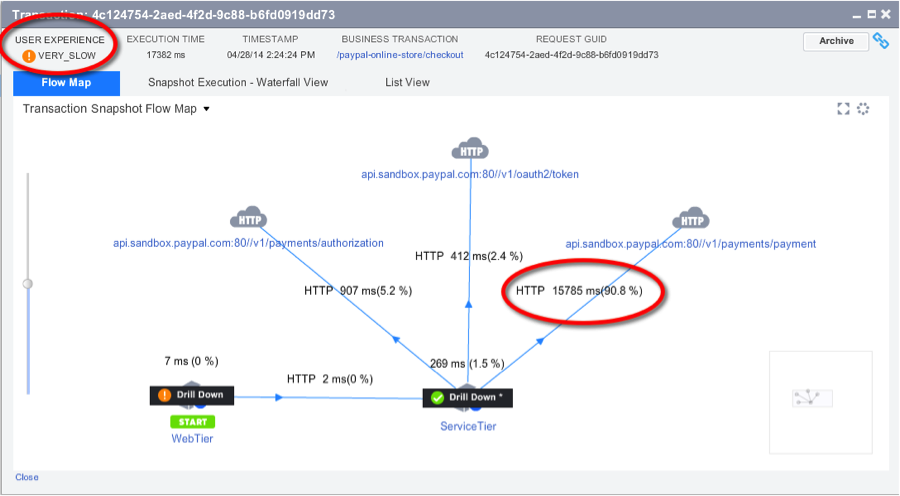By Steve Sturtevant, Sales Engineer at AppDynamics
In a previous post – Agile Performance Testing – Proactively Managing Performance – I discussed some of the challenges faced in managing a successful performance engineering practices in an Agile development model. Let’s continue this with a real world example, highlighting how AppDynamics simplifies the collection and comparison of Key Performance Indicators (KPIs) to give visibility into an Agile development team’s integration with PayPal as a Service (PPaaS).
Our dev team is tasked with building a new shopping cart and checkout capability for an online merchant. They have designed a simple Java Enterprise architecture with a web front-end, built on Apache TomEE, a set of mid-tier services, on JBoss AS 7, and have chosen to integrate with PayPal as the backend payment processor. With PayPal’s Mobile, REST and Classic SDKs, integrating secure payments into their app is a snap and our team knows this is a good choice.
However, the merchant has tight Service Level Agreements (SLAs) and it’s critical the team proactively analyze, and resolve, performance issues in pre-production as part of their Agile process. In order to prepare for meeting these SLAs, they plan to use AppDynamics as part of development and performance testing for end-to-end visibility, and to collect and compare KPIs across sprints.
The dev team is agile and are continuously integrating into their QA test and performance environment. During one of the first sprints they created a basic checkout flow, which is shown below:
For this sprint they stubbed several of the service calls to PayPal, but coded the first step in authenticating — getting an OAuth Access Token, used to validate payments.
Enabling AppDynamics on their application was trivial, and the dev team got immediate end-to-end visibility into their application flow, performance timings across all tiers, as well as the initial call to PayPal. Based on some initial performance testing everything looks great!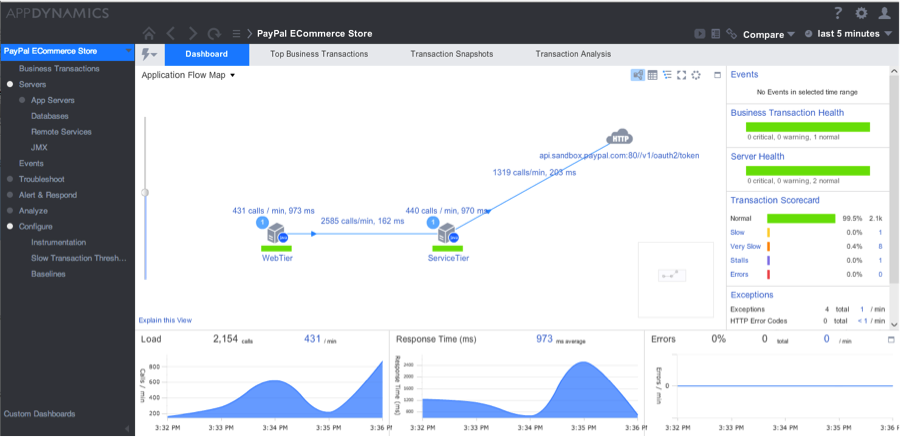
NOTE: in our example AppDynamics is configured to identify backend HTTP Requests (REST Service Invocations) using the first 3 segments of the target URL. This is an easy change and the updated configuration is automatically pushed to the AppDynamics agent without any need to change config files, or restart the application.
In a later sprint, our dev team finished integrating the full payments process flow. They’re using PayPal’s SDK and while it’s a seamless integration, they’re unclear exactly what calls to PayPal are happening under the covers.
Because AppDynamics automatically discovers, maps, and scores all incoming transactions end-to-end, our dev team was able to get immediate and full visibility into two new REST invocations, authorization and payment.
The dynamic discovery of AppDynamics is extremely important in an Agile, continuous integration, or continuous release models where code is constantly changing. Having to manually configure what methods to monitor is a burden that degrades a team’s efficiency.
Needing to understand performance across the two sprints, the team leverages AppDynamics’ Compare Releases functionality to quickly understand the difference between performance runs across the sprints.
AppDynamics flow map visualize the difference in transaction flow between the sprints, highlighting the additional REST calls required to fully process the payment. Also, the KPI comparison gives the dev team an easy way to quickly measure the differences in performance.
Performance has changed, as expected, when implementing the full payment processing flow. During a performance test AppDynamics automatically identifies and takes diagnostics on the abnormal transactions.
Transaction Snapshots capture source line of code call graphs, end-to-end across the Web and Service tiers. Drilling down across the call graphs, the dev team clearly identifies the payment service as the long running call.
For this sprint they stubbed several of the service calls to PayPal, but coded the first step in authenticating — getting an OAuth Access Token, used to validate payments.
Enabling AppDynamics on their application was trivial, and the dev team got immediate end-to-end visibility into their application flow, performance timings across all tiers, as well as the initial call to PayPal. Based on some initial performance testing everything looks great!
– See more at: http://www.appdynamics.com/blog/apm/understanding-performance-of-paypal-as-a-service-ppaas/#sthash.nj17U4ow.dpuf
AppDynamics provides full context on the REST invocation, and highlights the SDK was configured to talk to PayPal’s sandbox environment, explaining the occasional high-response times.
To recap, our Agile dev team leveraged AppDynamics to get deep end-to-end visibility across their pre-production application environment. AppDynamics release comparison provided the means to understand differences in the checkout flows across sprints, and the dynamic discovery, application mapping, and automatic detection allowed the team to quickly understand and quantify their interactions with PayPal. When transactions deviated away from normal, AppDynamics automatically identified and captured the slowness to provide end-to-end source line of code root-cause analysis.
Want to hear more? Join us for a webinar, Improve Your Application Performance with Complete Visibility into Real-User Experience, on October 16th at 2pm Eastern to learn how next-gen Application Performance Management can help you support your revenue-critical apps! This webinar is designed to provide you with a brief product overview, a live product demonstration, and an open forum for Q&A. We’ll discuss the APM market and how AppDynamics takes a different approach to tackling problems facing Dev, Ops, and business leaders today. Register here.
This post was written by Steve Sturtevant, Sales Engineer at AppDynamics, & originally appeared on the AppDynamics blog.

